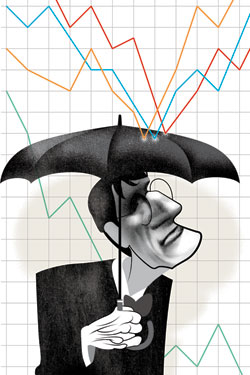By TOM SULLIVAN | MORE ARTICLES BY AUTHOR
A short seller sounds an alarm over states' deficits -- and bonds. Muni managers demur.
JAMES CHANOS, THE FAMED SHORT SELLER who was among the first to foresee the collapse of Enron, recently sounded the alarm on the municipal-bond market -- in the hallowed halls of the New York Historical Society, no less.
The "cracking of state and local municipalities is coming," he predicted at a recent meeting attended by Barron's staffer Susan Witty, adding that he wouldn't touch munis.
In a subsequent telephone interview with this columnist, Chanos said, "State and local municipal finance are a mess and going to get worse."
It's not just the recession, which has reduced tax receipts. Rather, he says the poor economy "is masking real problems in municipal cost structures." The big problem, he says, is "the platinum-plated health-care and retirement benefits" given to state and local workers. "It's all coming home to roost" as boomers start to retire.
California faces a $60 billion deficit, and the politicians there believe that in "a worst-case scenario, the federal government will bail them out," says Chanos. "If the feds do bail them out, as I believe they will," the state's bonds will likely lose their federal tax exemption, he adds.
He didn't mention New York, but he could have. Gov. David Paterson and the state legislature, controlled by the governor's own Democratic Party, are playing a game of chicken about where to find budget cuts to address a soaring deficit now estimated at $3.2 billion. Paterson has also warned that the state could run out of money to pay its bills before the end of the year.
Neighbor New Jersey faces an $8 billion structural deficit next year -- one reasons the normally blue state's voters elected Republican Chris Christie as governor last week. Ex-Governor James McGreevy had bonded for current-account expenses before he resigned, and the bonding was stopped by the state's courts. His Democratic successor, former Goldman Sachs honcho Jon Corzine, promised property-tax relief to the middle class but couldn't deliver, and therefore got the boot.
Given the scope of the problem, "munis are a bad bet," says Chanos.
But some muni asset managers beg to differ: "In the history of the market, going back to the Civil War," there have only been very isolated defaults, says Tom Spalding, senior investment officer at Nuveen Asset Management, with $63 billion of munis under management.
Chanos' retort: "Just because it hasn't happened doesn't mean it won't."
Gary Pollack, head of fixed-income trading at Deutsche Bank Private Wealth Management, with $6 billion in munis, says municipal governments, "are in the business of building public projects." To do that, they need access to the capital markets.
Yes, there's headline risk and there's downgrade risk from the credit-rating agencies, says Pollack. "But municipal governments have broad fiscal powers to balance the budget" to meet their payments in a timely fashion.
Moody's chief economist John Lonski says that "2010 will be the year of tax increases by local and state governments to close budgetary gaps."
Read his lips.
THE LATEST EMPLOYMENT DATA, released Friday, showed that the unemployment rate topped 10% (hitting 10.2%, to be exact) in October. That's the first time it exceeded 10% in 26 years.
"You can't doubt the impact of 10% on consumer behavior," especially given the record 5.4% drop in third-quarter employment income, which was first tracked in the 1950s, says Lonski. It also couldn't come at a worse time, just ahead of the holiday shopping season.
Retailers have braced for the worst. The unemployment rate for U.S. retail companies jumped to 9.9% last month, its highest level in the current recession, from 9.2% in September. Some 40,000 jobs were lost.
As for the near-0% interest-rate policy of the Federal Reserve, which it reaffirmed last week, "it would be premature to brace for the inevitable hike in fed funds," says Lonski. He doesn't see rates rising until August 2010 "at the earliest."
That's because the Fed doesn't see the private sector leading the recovery without the Fed's own stimulus programs, and those of the U.S. Treasury. "The Fed is very much concerned about the sustainability of the recovery," he says.
LONG TREASURIES AT FIRST rallied on the unemployment news, including a 190,000 drop in October's payrolls and a revised 219,000 decline in September, but pulled back ahead of this week's humongous supply.
The yield on the benchmark 10-year Treasury note ended the week at 3.50%, up from 3.38% the week before, as Treasury prices, which move inversely to yield, lost ground.
The Treasury Department is scheduled to sell $40 billion in three-year notes, $25 billion in 10-year notes and $16 billion in 30-year bonds as part of the refunding supply to raise cash for the fourth quarter.
Treasury won't have a major buyer this time, as the Fed last month completed its $300 billion Treasury-purchases program, essentially a policy of printing money.
One final note about the employment picture, and it's a positive one: The number of U.S. workers filing new claims for jobless benefits fell in the latest week (ended Oct. 31) more than economists expected -- by 20,000, to 512,000. That's the lowest level since Jan. 3. Economists anticipated a drop of just 5,000, according to Dow Jones Newswires.
The four-week moving average of new claims fell by 3,000, to 523,750, the lowest level since Jan. 10.
"Jobless claims are the best leading indicator" of where the employment picture is heading, says Lonski.
![[global]](http://barrons.wsj.net/public/resources/images/ON-AM961_bGloba_NS_20091106202603.gif)
Bond Supply Looms: U.S. government securities were under pressure last week, despite unemployment moving above 10% for the first time in 26 years, as the Treasury Department readied a record $81 billion in new supply for this week.











![[global]](http://barrons.wsj.net/public/resources/images/ON-AM961_bGloba_NS_20091106202603.gif)








